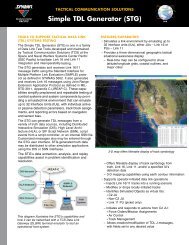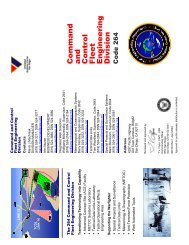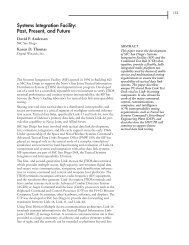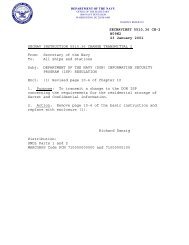Intelligence, Surveillance, and Reconnaissance - Spawar
Intelligence, Surveillance, and Reconnaissance - Spawar
Intelligence, Surveillance, and Reconnaissance - Spawar
Create successful ePaper yourself
Turn your PDF publications into a flip-book with our unique Google optimized e-Paper software.
shooters. This domain provides access to assured information whenever<br />
<strong>and</strong> wherever needed. This coherent view of the battlespace, from space<br />
to sea bed, will provide the Information Superiority required in today’s<br />
dynamic environment.<br />
Operational payoffs will include the following:<br />
• Improving a Comm<strong>and</strong>er’s situational analysis, awareness, <strong>and</strong> planning<br />
by leveraging the concepts of Smart Push (time-sensitive situational<br />
awareness <strong>and</strong> survival data where publishers provide streams of all<br />
available data in selected categories) <strong>and</strong> Intelligent Pull (where user<br />
queries initiate information delivery)<br />
• Enhancing interoperability by eliminating the current Common<br />
Operational Picture maritime track-centric approach <strong>and</strong> extending<br />
wide-area network (WAN) access to operationally relevant, nontrack-centric,<br />
non-geographically referenced data<br />
• Increasing "speed-to-capability"<br />
• Allowing tailoring of information on a plug-<strong>and</strong>-play basis to facilitate<br />
customizing <strong>and</strong> delivering the essential information <strong>and</strong> data services<br />
critical to a specified mission area<br />
• Providing distributed access to tactical data repositories (formerly<br />
restricted to a LAN environment) to widely dispersed forces<br />
• Making timely "raw" <strong>and</strong> processed multi-intelligence (multi-INT)<br />
data available to users<br />
• Eliminating unique Department of Defense (DoD) data synchronization<br />
<strong>and</strong> distribution issues:<br />
– Data duplication at nodes—creating unnecessary processing<br />
– Data ringing<br />
– Event-based "dumb push" of sensor events—wasting needed network<br />
capacity<br />
• Increasing the capacity of disadvantaged users to access tactically<br />
relevant data<br />
Ultimately, these operational payoffs will realize the overall objective of a<br />
relevant, consistent, <strong>and</strong> secure representation of tactical geo-spatial data<br />
that ensures a common basis of decision-supporting information.<br />
The eXtensible Tactical C4I Framework (XTCF) 155<br />
LCDR Mark V. Glover,<br />
USN<br />
MS, Information Technology<br />
Management, Naval<br />
Postgraduate School, 1996; MS<br />
in Computer Science, Naval<br />
Postgraduate School, 2001<br />
Current Research: Project<br />
Manager for the eXtensible<br />
Tactical C4I Framework, directing<br />
the planning, scheduling,<br />
budgeting, engineering, <strong>and</strong><br />
execution of this project, which<br />
is designed to provide infrastructure<br />
for the next-generation<br />
common operating picture.









